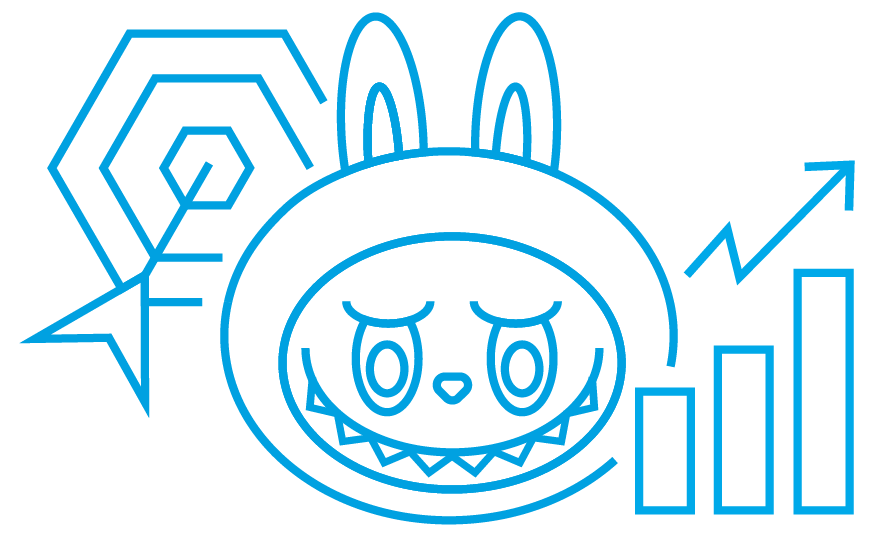- What Is the Labubu Phenomenon?
- Why Is Labubu So Popular?
- The Psychology Behind Collecting
- Stanley Cups: The Adult Version of Beanie Babies
- The Dark Side: Overconsumption and Manufactured Hype
- What Can Brands Learn?
- Global Scarcity: Why Labubu Is Rare in Many Countries
- How to Monetize on Labubu (or Any Trend)
- Conclusion: A Collector's Heart is a Marketer's Map
What Is the Labubu Phenomenon?
Labubu, the mischievous, “ugly-cute” character originally designed by Hong Kong-based artist Kasing Lung, is taking over shelves, social feeds, and resale platforms around the world. The character was introduced in 2015 as part of Lung’s “The Monsters” series-an imaginative collection inspired by Nordic mythology and folklore.
Initially, the gremlin-like creatures attracted little attention. That changed dramatically when Chinese toy giant Pop Mart, led by founder Wang Ning, acquired the rights and began distributing Labubu figures in blind boxes-sealed packaging that conceals the toy’s exact design. This element of surprise and scarcity catalyzed a collector frenzy.
While some may dismiss Labubu as just another collectible toy craze, savvy marketers recognize this as something more: a vivid example of how modern hype culture, emotional commerce, and digital storytelling collide.
The Labubu phenomenon is not just about designer toys-it’s about consumer psychology, algorithm-driven trends, and the new ways people signal identity and belonging. Brands and agencies would do well to observe what makes this moment tick, because understanding it can unlock opportunities far beyond toys.

Why Is Labubu So Popular?
Behind the Labubu Hype
Labubu’s appeal is rooted in modern pop culture dynamics:
- Scarcity & exclusivity: Limited-edition drops like the Labubu doll and Labubu keychain drive urgency.
- Social validation: Influencers and fan communities on TikTok build hype.
- Aesthetic resonance: The “ugly-cute” design reflects Gen Z and Millennial tastes.
- Emotional connection: Fans project personal meaning onto the characters, a concept referred to by Kantar as the “art of leaving blank space.”
Labubu is a plush toy that mirrors the success of its predecessor collectibles like Cabbage Patch Kids in the ’80s or Beanie Babies in the ’90s, both of which combined marketing scarcity with cultural emotion. As a designer toy, Labubu thrives on emotional commerce.
The Psychology Behind Collecting
Cultural Impact of Labubu and Collectibles
Collecting is not just a hobby-it’s a behavior grounded in psychology. According to Prof. Andrew Dillon’s article summarized and other studies:
- It fulfills a desire for identity expression.
- It creates a sense of control and order.
- It taps into nostalgia and childhood comfort.
- And for many, it sparks social belonging within collector communities.
Designer toys like Labubu and branded merchandise like the Stanley Cup evolve this into what marketing researchers call emotional commerce: the intertwining of personal emotion and consumerism.
Stanley Cups: The Adult Version of Beanie Babies
From Blind Box to Lifestyle Badge
The Stanley Cup surge isn’t just about hydration. It’s a lifestyle badge.
As highlighted in the OnAudience case study, the brand’s pivot to Gen Z and Millennial women, amplified by influencer marketing (Taylor Swift included), helped drive Stanley’s revenue from $70M to an estimated $750M in 2023.
- Resale markets with inflated prices
- Scarcity marketing via color drops
- Community identity, especially in “Utah mom” culture on TikTok
The result? A surge in demand that caused supply chain breakdowns and product shortages.
The Dark Side: Overconsumption and Manufactured Hype
When Popularity Outpaces Purpose
Not all trends are harmless. As noted in Reddit forums and publications like Fast Company, these fads often lead to:
- Environmental waste from overproduction and plastic packaging
- Unethical resale practices and scalping
- Emotional manipulation via FOMO and false urgency
The Stanley Cup craze even saw fire-resistant cups being sold after a viral car fire video, blurring the line between safety and opportunism.
What Can Brands Learn?
Lessons from the Cultural Impact of Labubu
- Act Fast, But Think Long-Term: Use web data to detect early signs of cultural momentum. However, don’t build your brand only on momentary hype.
- Personalize Targeting: OnAudience’s data helps brands identify audiences interested in any emerging trend-from niche fandoms to global hype cycles. For instance, our datasets include signals from all major markets, including Asia, with enriched insights into pop culture, food, drink, Korean cosmetics, and of course-Labubu. Whether your brand wants to cross-sell to Labubu lovers or compete with collectible-style alternatives, you can now build a highly focused audience in seconds. Just paste your brief into AI Audiences, instantly explore who you can target, and we’ll deliver your custom segment to the DSP of your choice.
- Create Emotional Value: Consider how your product can be a canvas for self-expression, not just a Stock Keeping Unit (SKU) or accessory.
- Plan for Demand Spikes: Trend surges strain logistics. Inventory and supply chain forecasting must adapt.
- Be Responsible: Don’t manufacture scarcity without thinking through its ethical impact.
In addition, Pop Mart’s innovative distribution model and branding offer lessons. As the creator and exclusive retailer of Labubu collectibles, Pop Mart’s global expansion and control of supply through blind box drops and online lotteries create both hype and demand management.
Global Scarcity: Why Labubu Is Rare in Many Countries
Sold Through Limited Channels
Labubu figures-especially original Labubu dolls and Labubu keychains-are difficult to find not just in the UK, but in many international markets. High demand, limited production runs, and region-specific releases sold through Pop Mart’s platform make them a rare sight outside Asia. This lack of global availability has turned Labubu into a prime target for secondary markets and collectors willing to pay a premium.
How to Monetize on Labubu (or Any Trend)
Audience Targeting That Follows the Craze
Programmatic advertising makes it possible to respond to real-time hype without wasting media spend. Using AI-enriched segments that OnAudience offers:
- Brands can target Labubu fans with matching lifestyle products
- Retailers can promote limited-edition drops to those primed to engage
- Beauty brands can ride the wave by offering Labubu-inspired aesthetics
With tools like AI Audiences, these segments are fast to build, transparently enriched, and easily licensed across major DSPs. Audience targeting can now focus on passion and context.
Conclusion: A Collector’s Heart is a Marketer’s Map
Beyond the Labubu Phenomenon
Labubu isn’t just a craze-it’s a cultural phenomenon and a marketing case study. Understanding why people collect gives marketers a powerful lens into identity, community, and emotion. Above all, what we’re seeing today is not a flash in the pan, but part of a broader generational shift toward emotionally charged consumer choices.
The Labubus phenomenon reflects a fusion of nostalgia, identity, and pop culture, tied together with scarcity and digital storytelling. This isn’t limited to toys-it’s part of a rising demand for products that double as expressions of personality, connection, or even status. From plush toys to blind box releases to viral TikTok trends, these cultural triggers offer marketers a roadmap to build affinity through meaning, not just visibility.
Those who treat these trends as fleeting fads will miss the bigger picture. However, those who understand the psychology behind them-and act with data, speed, and respect-can turn a moment into a movement. The real opportunity lies in treating collectible trends as case studies in emotional branding, behavioral insight, and ethical engagement. In doing so, you build not just buzz-but brand loyalty.
At OnAudience, we support this approach at scale offering everything from custom audience segments to raw data streams. Our platform processes data from over 25 billion devices across 200+ markets, with 3,000+ predefined segments ready to activate. Whether you need to react fast to a trend like Labubu or plan for long-term affinity, we’re here to help you make cultural targeting both smart and scalable.




